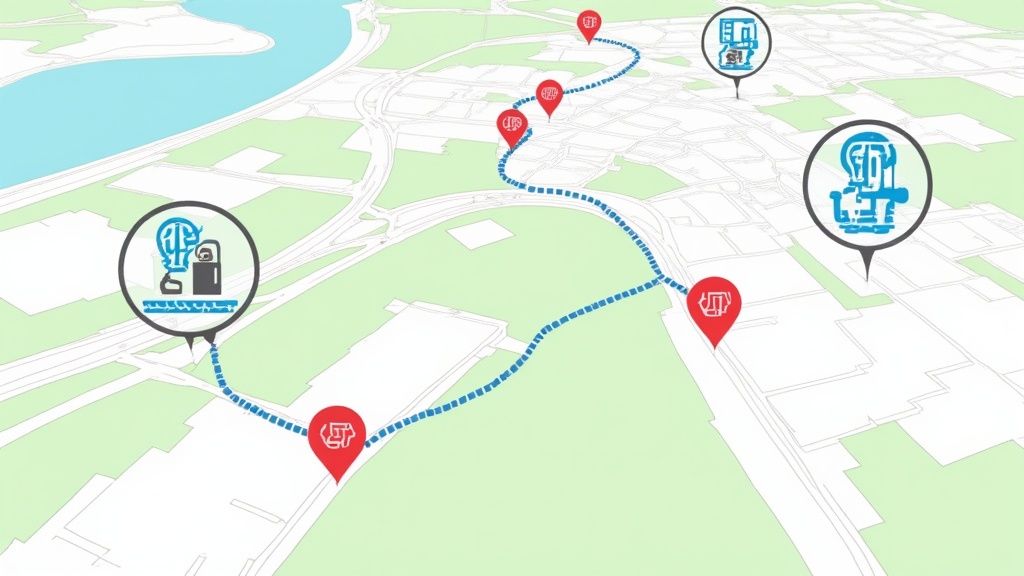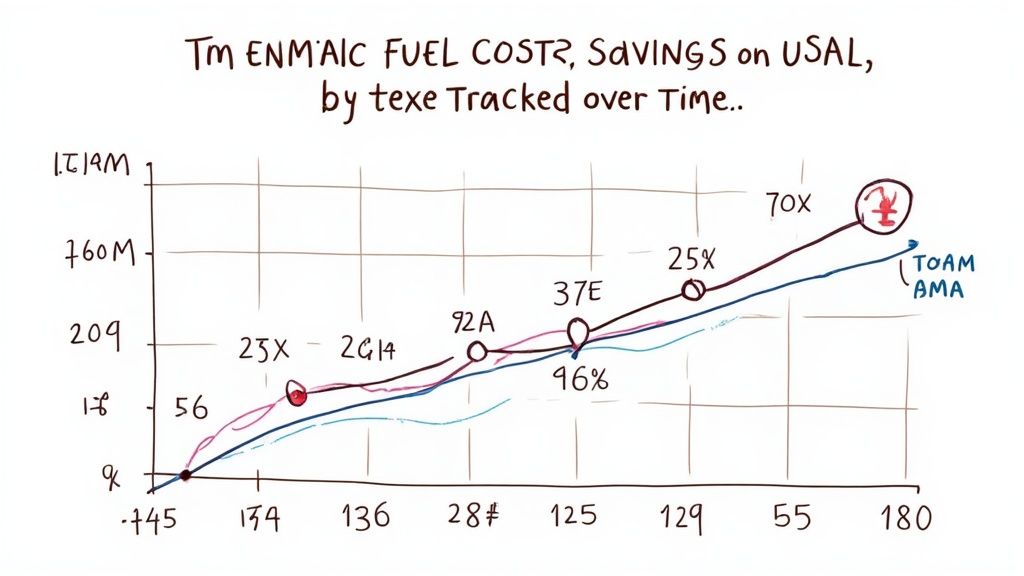
Fuel Consumption Tracker: A Complete Guide to Smart Energy Management
Why Smart Energy Tracking Matters Now

Global energy consumption continues to hit new records year after year. With rising fuel costs and growing environmental concerns, managing energy use effectively has become essential for both businesses and individuals. This makes tracking fuel consumption more important than ever. Just as managing household expenses requires careful monitoring of spending, optimizing energy usage depends on having accurate data and insights. Without proper tracking tools, identifying opportunities to reduce waste and improve efficiency becomes nearly impossible.
The Hidden Costs of Inaction
Many companies still rely on basic spreadsheets and manual logs to track their fuel usage. These outdated methods often result in data gaps and errors that mask real problems like poor driving habits or maintenance issues requiring attention. The impact is similar to a dripping faucet - what seems like minor inefficiencies day-to-day can add up to major losses over time. Organizations need to take a more systematic approach to fuel management to avoid these hidden costs. You might be interested in: How to master…
Transforming Data Into Actionable Insights
Effective fuel consumption tracking provides more than just numbers - it delivers clear insights that enable smarter decisions. By monitoring usage patterns, businesses can spot trends, identify problem areas, and create targeted plans for improvement. This allows companies to move beyond simply collecting data and actually make changes that positively impact their bottom line. However, having access to information alone isn’t enough.
Fuel Consumption Trackers: A Competitive Edge
Businesses are constantly working to reduce operating costs and gain advantages over competitors. Fuel tracking technology offers a powerful way to achieve both goals. For example, a logistics company that uses tracking data to cut fuel consumption by just 10% can significantly lower expenses compared to competitors who haven’t optimized their usage. Smart energy monitoring has become essential for businesses focused on long-term success.
Beyond Basic Tracking: A Holistic Approach
Today’s fuel tracking systems do much more than basic monitoring. Features like route optimization, driver behavior analysis, and real-time alerts help businesses address all factors affecting consumption. Many systems also integrate with other business software to provide a complete view of energy usage across operations. This comprehensive approach enables more strategic management of fuel resources, making tracking tools an increasingly vital part of modern business operations.
Selecting Your Perfect Fuel Consumption Tracker
Smart fuel tracking isn’t just a “nice to have” anymore - it’s essential for managing costs and environmental impact. But with so many options available, finding the right solution requires careful evaluation of your specific needs. This guide will help you navigate the different types of trackers and key features to consider when making your choice.
Types of Fuel Consumption Trackers
The market offers several approaches to fuel tracking, each with distinct capabilities and use cases:
-
Basic Spreadsheet and Logbook Methods: While inexpensive, manual tracking through spreadsheets or paper logs has clear limitations. Like trying to manage complex finances with just a notebook, these methods make it hard to spot usage patterns or identify opportunities for improvement.
-
Smartphone Apps: Mobile applications provide convenient tracking by using GPS to automatically record mileage. While more user-friendly than manual methods, most apps lack advanced analytics and system integration capabilities.
-
OBD-II Devices: These plug-in devices connect directly to your vehicle’s diagnostic port to capture real-time data about fuel use and engine performance. They work like a continuous health monitor for your vehicle, providing detailed insights into consumption patterns.
-
Telematics Systems: Fleet managers often choose telematics solutions that combine GPS tracking, diagnostics, and driver monitoring. This allows them to optimize routes, reduce idle time, and promote safer driving habits through comprehensive data analysis.
-
Integrated IoT Systems: For larger operations, IoT platforms can connect fuel pumps, vehicle sensors, and external data sources to build a complete picture of fuel usage. This integration enables predictive analytics and deep optimization insights.
Key Features to Consider
When evaluating fuel tracking options, focus on these important capabilities:
-
Automated Data Capture: Look for systems that automatically log mileage and fuel purchases to eliminate manual entry errors and save time for analysis.
-
Real-Time Monitoring: Choose solutions providing instant access to fuel data so you can quickly address problems and adjust behaviors.
-
Driver Behavior Analysis: Select trackers that can identify driving patterns affecting fuel economy, enabling targeted training to improve efficiency.
-
Reporting and Analytics: Ensure the system generates clear reports and visualizations that help translate raw data into actionable cost savings.
-
Integration with Existing Systems: Pick solutions that work smoothly with your current software for accounting, maintenance and other business functions.
-
Scalability: Choose a tracker that can grow alongside your needs, whether that means adding vehicles or expanding functionality.
The right fuel consumption tracker puts you in control of your fuel costs while supporting better efficiency and sustainability. By matching your requirements to available features and capabilities, you can select a solution that delivers real value through improved tracking and optimization. Remember - effective fuel tracking isn’t just about collecting data, it’s about using those insights to drive measurable improvements.
Setting Up Your Tracking System for Success

Creating an effective fuel consumption tracking system requires careful planning and dedication to collecting accurate data. While selecting the right tools is important, having a clear setup process and staying committed to tracking fuel usage will deliver the insights needed to improve efficiency. Let’s explore how to build a tracking system that provides real value.
Implementation Best Practices
Getting started with fuel tracking requires a methodical approach. Here are the key steps to take:
-
Defining Objectives: Start by identifying your specific goals for fuel tracking. Do you want to cut costs, reduce environmental impact, or accomplish both? Clear targets, like reducing fuel use by 10% in one year, help measure progress and guide your efforts.
-
Data Collection Procedures: Create standard methods for recording fuel purchases, mileage, and other key data points. For example, require drivers to submit receipts for each fuel purchase and log odometer readings consistently. These practices ensure accuracy no matter who enters the information.
-
Team Training: Proper training helps prevent errors and builds support for the new system. Cover practical topics like using the tracking tools, fixing common issues, and explain why accurate data matters. When team members understand the value, they’re more likely to participate fully.
-
System Integration: Connect your fuel tracking with other key business tools like accounting or fleet maintenance software. This gives you a complete view of operations and helps identify patterns. For instance, you might spot maintenance problems that lead to higher fuel consumption.
Overcoming Common Challenges
New systems often face obstacles. Here’s how to handle typical issues:
-
Resistance to Change: Some staff may hesitate to adopt new processes. Address concerns openly, explain the benefits clearly, and ask for input on improvements. Show you value their perspective while moving forward with needed changes.
-
Data Accuracy Concerns: Quality data is essential. Put regular checks in place, like comparing reported mileage to GPS records or reviewing fuel receipts for unusual patterns. Catch and fix errors quickly to maintain reliable information.
-
Maintaining Momentum: Fuel tracking requires ongoing attention. Keep the team engaged by reviewing results monthly, setting fresh goals, and recognizing good performance. Celebrate wins like improved fuel efficiency to show the system’s value.
Building a Sustainable System
Think of fuel tracking as an evolving process rather than a one-time project. Consider these factors for lasting success:
-
Regular System Audits: Review your tracking methods periodically to ensure they still meet your needs. As your business grows or technology improves, you may need to upgrade software, add features, or refine how you collect data.
-
Continuous Improvement: Use your tracking data to find opportunities for better fuel efficiency. Study trends, identify waste, and develop targeted solutions. If data shows excessive idling, for example, provide focused driver training on reducing idle time. Like managing a budget, consistent monitoring and adjustments lead to better results over time.
Turning Raw Data Into Action Plans
A fuel consumption tracker is just the beginning. The true value comes from analyzing the data and using those insights to create effective plans for cutting costs and improving efficiency. This means going deeper than surface-level numbers to understand what’s really driving your fuel usage patterns.
Identifying Trends and Anomalies
Effective fuel tracking goes beyond basic mileage and cost data. The key is spotting meaningful patterns that might otherwise stay hidden. For instance, you may notice consistently higher fuel use during certain time periods or on specific routes. These insights can point to issues like traffic congestion or route inefficiencies. It’s also important to watch for unusual spikes or drops in fuel consumption, which could signal vehicle problems, poor driving habits, or even theft. Think of it like monitoring vital signs - recurring irregularities often reveal underlying issues that need attention.
Benchmarking and Setting Realistic Targets
To reduce fuel costs effectively, you first need to know your starting point through careful benchmarking. Review historical data to establish baseline performance metrics, like average fleet fuel consumption over the past six months. With clear benchmarks in place, you can then set achievable improvement goals. Rather than aiming for dramatic overnight changes, focus on steady, incremental progress - perhaps targeting a 5% reduction in the first quarter followed by an additional 3% in the next. This measured approach tends to be more sustainable than pursuing aggressive cuts all at once. Learn more in our article about How to master…
Measuring Progress and Refining Strategies
Consistent monitoring is essential for tracking progress toward your fuel reduction goals. Develop a simple system to measure key metrics like miles per gallon, cost per mile, and total fuel expenses. Present this data in clear reports and visual dashboards that make it easy to see improvements. But tracking alone isn’t enough - you also need to adjust your approach based on what the numbers tell you. If certain initiatives like driver training aren’t delivering expected results, try new tactics focused on specific behaviors revealed by your fuel tracking data.
From Data to Action: A Practical Example
Consider a delivery company that discovers through fuel tracking that excessive idling is driving up costs. This insight becomes the catalyst for several targeted changes: implementing driver education on reducing idle time, adding automatic engine start/stop systems to vehicles, and creating incentives for drivers who improve their fuel efficiency. By turning data into specific actions, the company achieves major fuel savings while reducing environmental impact. This shows how combining careful tracking with thoughtful analysis and targeted improvements can create real, measurable results. The goal isn’t just gathering data - it’s using those insights to make smarter decisions and continuously improve your fuel management.
Maximizing ROI Through Smart Optimization

Getting real value from your fuel consumption tracker means putting the data to work. Simply collecting information isn’t enough - the key is taking concrete actions based on those insights to reduce fuel usage and improve efficiency across your operations.
Turning Insights Into Action: Behavior Change Management
Driver behavior has one of the biggest impacts on fuel efficiency. Modern tracking systems can identify specific patterns like excessive idling, speeding, and aggressive braking that waste fuel. Research shows that aggressive driving alone can reduce fuel economy by up to 33% on highways and 5% in cities. The good news is that by providing personalized feedback and training based on tracking data, companies can help drivers develop more efficient habits. For instance, creating incentive programs that reward consistently good fuel economy performance encourages positive changes.
Making Technology Work Together: System Upgrades and Integrations
Your fuel tracker becomes even more powerful when combined with other smart tools. For example, connecting it with route planning software helps identify the most efficient paths and reduces unnecessary miles driven, especially for larger fleets. A delivery business might use this combination to adjust routes in real-time based on traffic conditions, leading to major improvements in both fuel use and delivery times. Simple upgrades like automatic engine stop-start systems can also make a big difference by eliminating wasted fuel from idling.
Prioritizing Optimization Efforts for Maximum Impact
With many potential ways to optimize fuel use, it’s important to focus on the biggest opportunities first. Start by analyzing your tracking data to find the main sources of waste - whether that’s excessive idling time, inefficient routes, or other factors. Target those key areas before moving on to smaller improvements. This focused approach ensures you get the best results from your optimization efforts. You might be interested in: How to master…
Building a Business Case for Energy Efficiency Investments
Getting support for efficiency initiatives requires showing clear financial benefits. Use your fuel tracking data to project potential cost savings under different scenarios. This evidence-based approach helps justify investing in fuel-saving technologies and programs. With global energy use hitting new records in 2023, smart fuel management is more critical than ever. When you can demonstrate that even a 10% reduction in fuel consumption translates to thousands in annual savings, it becomes much easier to make the case for efficiency investments.
Moving Forward with Energy Tracking

Efficient fuel tracking requires more than just optimizing current processes. As energy sources and technologies change, businesses need to adapt their tracking methods to stay effective. This means keeping up with new developments while building systems flexible enough to handle future changes.
Building Tomorrow’s Tracking Systems
Several key shifts are reshaping fuel tracking practices. The growing use of solar and wind power means tracking systems must now monitor diverse energy sources beyond traditional fuels. Electric vehicles (EVs) also bring new tracking needs - instead of gallons of gas, companies track kilowatt-hours and charging patterns. As more businesses adopt EVs, having systems that can handle both conventional and electric fuel tracking becomes essential.
Making the Most of Smart Grid Technology
Smart grids are changing how we track and manage energy use. These systems provide detailed, real-time data about energy consumption and enable precise monitoring of different fuel sources. For example, smart grid technology can automatically adjust energy use based on current grid conditions to reduce costs. Data analysis tools can spot usage patterns and suggest ways to improve efficiency. This combination of smart infrastructure and analytics gives businesses much better insight into their fuel consumption.
Keeping Up with New Rules
Energy regulations continue to evolve, with governments implementing stricter emissions standards and sustainability requirements. Businesses need tracking systems that can collect and report the right data to stay compliant. Some rules may require specific emissions reporting, which means having accurate, comprehensive fuel tracking. Market changes also affect fuel costs and availability. To manage these challenges, companies should consider using multiple energy sources, planning for price changes, and investing in efficiency improvements.
Taking Action to Future-Proof Your Systems
Here are key steps to keep your fuel tracking effective over time:
- Choose adaptable systems: Select tracking tools that can handle new energy sources and technologies as they emerge
- Connect to smart grid systems: Take advantage of real-time data and advanced controls
- Use data analysis: Apply analytics to understand usage patterns and find ways to improve
- Monitor regulatory changes: Stay current on rules affecting fuel tracking and reporting
- Plan for the long term: Develop an energy strategy that considers future trends and requirements
By taking these steps, you can build a fuel tracking system that continues to help manage costs and meet sustainability goals as energy technology advances.
Ready to improve your fuel tracking? Auto Service Logger provides complete vehicle maintenance and fuel consumption tracking. Visit us to start optimizing your fuel use today.